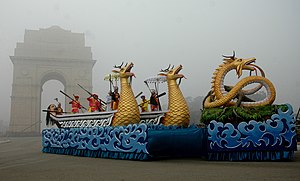
Back Phouoibi English फौओइबी Hindi Phouoibi HIF ꯐꯧꯑꯣꯏꯄꯤ MNI பௌ-ஒய்பி Tamil Фуойбі Ukrainian فووبی Urdu
| Phouoibi | |
|---|---|
Goddess of agriculture, crops, fertility, grains, harvesting, paddy, rice and wealth | |
| Member of Lairembis | |
 Goddess Phouoibi | |
| Other names | Fouoibi, Fouoipi, Fouleima, Foureima, Phouoipi, Phouleima, Phoureima |
| Meitei | |
| Affiliation | Meitei mythology (Manipuri mythology) and religion (Sanamahism) |
| Abodes | Farms and Fields |
| Artifacts | Round black stone kept inside a pot |
| Symbol | Paddy |
| Texts | Phouoibi Warol |
| Gender | Female |
| Region | Ancient Kangleipak (Antique Manipur) |
| Ethnic group | Meitei ethnicity |
| Festivals | Lai Haraoba |
| Personal information | |
| Consort | Phou Ningthou |
| Parents |
|
| Siblings | Thumleima, Ngaleima and Ereima (Ireima) |
| Greek equivalent | Demeter |
| Roman equivalent | Ceres |
Phouoibi (Fouoibi) or Phouoipi (Fouoipi) or Phouleima (Fouleima) or Phoureima (Foureima) is the goddess and the female personification of the agriculture, crops, fertility, grains, harvest, paddy, rice and wealth in Meitei mythology and religion of Ancient Manipur (Antique Kangleipak).[1][2][3][4] She is the lover of Akongjamba, a hero in ancient legends.[5] But fate doesn't permit the lovers to unite. So, Phouoibi and Akongjamba reincarnated in the legends.[2][4] She was sent by Thangjing to Kege Moirang (Keke Moilang) to prosper the human world.[6] The lives of the two legendary lovers were believed to be enacted by Thangjing as a part of the Moirang Saiyon of the Moirang Kangleirol legends.[7]
Phouoibi is a spirit of the rice. So, she is not a member of the Umang Lais.[8]
The characters of Phouoibi and other goddesses including Panthoibi and Emoinu depict as well as influence the boldness, courage, independence, righteousness and social honour of Meitei women.[9] The Meitei people believe that the gleaming black stone is a personification of the goddess, which if kept inside the earthenware pot of the granary, will bring good luck and prosperity, as long as it shines.[10][11]
- ↑ Paniker, K. Ayyappa (1997). Medieval Indian Literature: Surveys and selections. Sahitya Akademi. ISBN 978-81-260-0365-5.
- ↑ 2.0 2.1 Devi, Lairenlakpam Bino (2002). The Lois of Manipur: Andro, Khurkhul, Phayeng and Sekmai. Mittal Publications. ISBN 978-81-7099-849-5.
- ↑ Sanajaoba, Naorem (1993). Manipur: Treatise & Documents. Mittal Publications. ISBN 978-81-7099-399-5.
- ↑ 4.0 4.1 Meitei, Sanjenbam Yaiphaba; Chaudhuri, Sarit K.; Arunkumar, M. C. (2020-11-25). The Cultural Heritage of Manipur. Routledge. ISBN 978-1-000-29637-2.
- ↑ Oinam, Bhagat; Sadokpam, Dhiren A. (2018-05-11). Northeast India: A Reader. Taylor & Francis. ISBN 978-0-429-95320-0.
- ↑ Session, North East India History Association (1999). Proceedings of North East India History Association. The Association.
- ↑ Lisam, Khomdan Singh (2011). Encyclopaedia Of Manipur (3 Vol.). Gyan Publishing House. ISBN 978-81-7835-864-2.
- ↑ Parratt, Saroj Nalini (1980). Religion Of Manipur. Firma Klm. p. 91.
- ↑ Kipgen, Tingneichong G. (2010). Women's Role in the 20th Century Manipur: A Historical Study. Gyan Publishing House. ISBN 978-81-7835-803-1.
- ↑ PhD, Patricia Monaghan (2014-04-01). Encyclopedia of Goddesses and Heroines. New World Library. ISBN 978-1-60868-218-8.
- ↑ Hamilton, Roy W.; Ammayao, Aurora (2003). The Art of Rice: Spirit and Sustenance in Asia. UCLA Fowler Museum of Cultural History. ISBN 978-0-930741-98-3.
